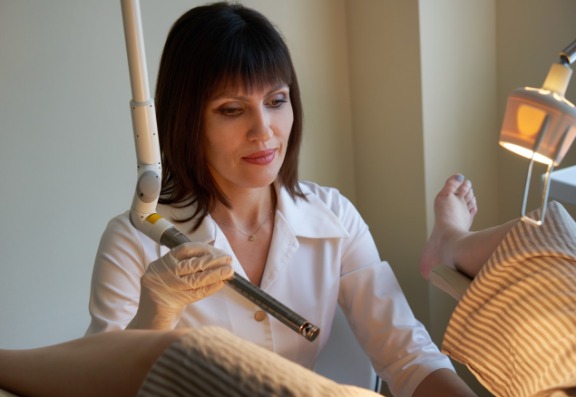Vaginal laxity (loosening or loss of tonicity of the vaginal wall and vaginal opening) is a common presentation among women after childbirth and menopause with physical and psychological impacts such as diminished or loss of sensation during intercourse that leads to unsatisfied sexual life, loss of confidence and low self-esteem affecting the intimate relationship.1-3
Vaginal Laxity is the main cause of sexual dissatisfaction. Vaginal laxity lacks standardised diagnosis and severity criteria. It is considered a subjective complaint that reflects decreased sexual satisfaction due to vaginal loosening.
It has been estimated that up to 40% of women have complaints of sexual problems, including decreased libido, vaginal dryness, pain with intercourse, decreased genital sensation and difficulty or inability to achieve orgasm.4-6
Vaginal Laxity, How it Happens Following Childbirth:
Vaginal laxity occurs during childbirth when the vaginal tissue and lining are thinned out and stretched to accommodate the delivery of the baby.
Vaginal Laxity happens after several deliveries or big-size babies, where the vaginal wall and its opening become unable to retract back to their initial shape or size due to overstretching and loss of the pelvic muscles’ tone that surrounds the vaginal opening -either due to mechanical overstretch or due to birth tears/injuries- resulting in looseness and weakness of vaginal tissues.
Vaginal laxity syndrome is the term describing a group of symptoms resulting from the disruption of the pelvic floor muscles and manifesting as loose vaginal opening, diminished sexual sensation, urine leakage and stool leakage (faecal urgency or incontinence) 7-9
Vulvovaginal Atrophy (VVA)/ Genitourinary Syndrome of Menopause (GSM), What is it?
Vaginal laxity at menopause is due to declining of Oestrogen hormone production which leads to loss of volume and strength of many feminine tissues that contain Oestrogen receptors that help to maintain the youthful shape and function. At menopause, atrophy (shrinkage) of tissues happens.
There is a reduction in the plumpness (bulk/mass) of the pelvic floor muscles and in the vaginal and urinary areas due to the diminishing of Oestrogen and its receptors mediating or responsible for both the well-being and function of the structures in the feminine area. A deficiency of Oestrogen hormone eventually leads to vaginal dryness and laxity.

Vaginal Laxity is taboo! Women are reluctant to talk about it because they think it is embarrassing! Many women suffer in silence. They are convinced that the condition of vaginal laxity is part of the natural ageing process and that is inevitable to happen and there is nothing that would correct it but surgery.
They struggle with a decrease in sexual satisfaction due to lack of enough physical friction during intercourse, (due to loose vaginal opening and the surrounding muscle tone) and diminished or loss of sensation and natural lubrication function.
This elicits the symptoms of pain during intercourse (dyspareunia) or sensation of “cactus dryness” or irritation or burning sensation or uncommon cracks in the vaginal wall with the occurrence of spotting or bleeding following intimacy.
The combination of all these symptoms comes under the terminology or the diagnosis of Vulvo-Vaginal Atrophy (VVA) or Genitourinay Syndrome (GSM) is a combination of vulvovaginal laxity, vaginal atrophy, urinary incontinence, and orgasmic dysfunction).
The GSM symptoms include genital symptoms (dryness, burning, itching, irritation, bleeding), sexual symptoms (dyspareunia and other sexual dysfunctions) and urinary symptoms (dysuria, frequency, urgency, recurrent urinary infections 10-12
Vaginal Laxitys: How to Treat
I) Surgical Treatment
Vaginal Laxity can be treated by traditional surgical procedures called vaginoplasty (Anterior Coloporrahpy, Posterior Colpoperineorrahpy, Manchester-Fothergill repair, perineoplasty and vaginal vault prolapse etc. The surgical option requires lengthy preparation, anaesthesia, stay in the hospital and a long time for recovery, not to mention the inherent risks of surgery and potential complications including scar tissue formation. 13-15
Female Sexual Dysfunction Following Vaginal Surgery
A significant percentage of women report pain during intercourse. Some patients experience improved overall sexual function due to complete relief from coital incontinence.
It is worth mentioning that the purpose of surgery is achieving anatomical tightening of the vaginal wall, but it does not lead to improvement in the function or the quality of the already atrophic vaginal tissues.16, 17
II) Non-Surgical Options: What are They?
1) Conservative
1.1. Pelvic Floor Exercises (Kegel’s)/Physiotherapy
These aim to tighten the muscles surrounding the vaginal opening and improve the resting muscle bulk and tone. These exercises should be routinely done at least 3 times a day for 10-15 minutes daily and indefinitely.18, 19
1.2 Hormonal Replacement Therapy - How Useful is VVA?
The use of Oestrogen Hormone Replacement (EHT) is meant to improve and reverse the atrophic changes happening in the vaginal wall. It improves the quality of vaginal tissues enhancing blood flow and thickening and abundance of the cellular element of the lining vaginal skin; an effect mediated by the Oestrogen receptors. Topical applications are usually advised to avoid or minimise the side effects. Forms like Creams, pessary, and vaginal rings are usually prescribed to be applied for a two or three month-course that can be repeated every 3 months.
Vaginal Laxity is not expected to be improved by the ERT, but the lubricating function will be regained.20-22
What Are the New Trends in Non-Surgeical Treatment of Vaginal Laxity?
1.3 Non-Hormonal Non-Surgical Aesthetic/Regenerative Gynaecology procedures
Nowadays most women are choosing the non-surgical “Aesthetic” better called “Regenerative Gynaecology” TM options such as the use of Hyaluronic Acid Fillers or autologous cell grafting or autologous lipofilling, Gold Thread Implantation radiofrequency and laser; all these aiming to tighten and rejuvenate vaginal tissues.23-28
Platelet Rich Plasma Injections (also known as O Shot): the use of an autologous platelets sample after centrifuging the person’s blood sample and injection in certain points -by the experienced Gynaecologist Dr Nadia Yousri- to stimulate tissue regeneration and vaginal rejuvenation. It has excellent results with the expert hand. Platelet-rich plasma (PRP) can be incorporated into genital rejuvenation.29-34
The use of PRP as a supplement to cell culture media has consistently been shown to potentiate stem cell proliferation, migration, and differentiation. In addition, the clinical utility of PRP is supported by evidence that PRP contains high concentrations of growth factors (GFs) and proteins which contribute to the regenerative process. PRP-based therapies are cost-effective and also benefit from the accessibility and safety of using the patient's own GFs. In the last years, great development has been witnessed in PRP-based biomaterials, with both structural and functional purposes.
Genital rejuvenation involves the management of extrinsic (traumatic) and intrinsic (ageing) changes in the vagina and scrotum. Lipofilling-with the additional injection of PRP (with or without hyaluronic acid)-has been used to successfully treat vaginal atrophy and vaginal laxity; the unexpected resolution of Lichen Sclerosis in one of the women prompts the consideration to initially use PRP for the treatment of this condition not only in women but also men.35-38

Vaginal Laxity and Laser treatment for vaginal tightening.
Laser has become increasingly popular for enhancing/gratification of sexual and orgasmic function along with the treatment of vaginal laxity by gently ablating the weakened tissue in the vaginal wall that improves vascularisation and stimulating the natural body healing process promoting fibrin and collagen deposition. The new collagen and elastin formation improves lubrication and restores the strength and elasticity of the vaginal wall and the supporting connective tissue matrix.
The procedure is painless, and takes a few minutes, with 5-7 days of downtime. It may take up to 3 sessions to achieve the targeted success rate.
In a study published in 2021 that included 84 pre-menopause women, with a mean age of 47.7 years who had CO2 Laser treatment for vaginal laxity with diminished sexual satisfaction, it was shown that CO2 laser treatment has both a statistically and clinically significant effect on participants' complaints and sex-life, which wanes by 6 months post-treatment. Laser therapy seems to be safe in the short term, with no serious adverse events reported in the current study.39-43
Radiofrequency for Vaginal Tightening:
Radiofrequency is used to induce regeneration of the tissues by warming up the lining of the vagina and the vulva to induce collagen and elastin formation, improve blood flow and increase moisture in the vagina which makes the tissues tighten so the vaginal walls are stronger and plumper.
The treatment is painless and takes about 20 minutes and creates a gentle warming sensation. 44-53
Vaginal Laxity, How it Happens Following Childbirth:
Vaginal laxity occurs during childbirth when the vaginal tissue and lining are thinned out and stretched to accommodate the delivery of the baby.
Vaginal Laxity happens after several deliveries or big-size babies, where the vaginal wall and its opening become unable to retract back to their initial shape or size due to overstretching and loss of the pelvic muscles’ tone that surrounds the vaginal opening either due to mechanical overstretch or due to birth tears/injuries resulting in looseness and weakness of vaginal tissues.
Vaginal laxity syndrome is the term describing a group of symptoms resulting from the disruption of the pelvic floor muscles and manifesting as loose vaginal opening, diminished sexual sensation, urine leakage and stool leakage (faecal urgency or incontinence) 7-9
All references can be found here.
If you want to read more, the experts at Consulting Room really know what they're talking about and have put together vaginal loosening, vaginal dryness, vulvovaginal laxity, scarring, Hormone Replacement, dermal Fillers, Platelets’ Rich Plasma Injections and genital rejuvenation FAQs just for you.
If you have more questions, you can use the vaginal loosening, vaginal dryness, vulvovaginal laxity, scarring, Hormone Replacement, dermal Fillers, Platelets Rich Plasma Injections and genital rejuvenation questions feature to talk to our panel of trained medical experts.
If you're keen to get started with any of these treatments immediately, then you're in luck. Those clever folks also have a list of trusted, accredited vaginal loosening, vaginal dryness, vulvovaginal laxity, scarring, Hormone Replacement, Dermal Fillers, Platelet Rich Plasma Injections and genital rejuvenation clinics in your area.
Many thanks to the author of this blog, Dr Nadia Yousri who is the owner of Dr Nadia Yousri OBandGY.
Doctor Nadia Yousri is Triple Qualified OBandGY Surgeon (FRCOG, MRCOG, PhD in OBandGY, Master's Degree in OBandGY, DFSRH) and is a highly qualified and experienced Obstetrician, Gynaecologist, Fertility, Sexual Wellness, Aesthetic Gynaecology and Regenerative Medicine Specialist Consultant.
Call Dr Nadia Yousri now on 0777 576 1050 or visit www.drnyaesthetics.com.

A recent investigation by 5 News has raised alarm over UK clinics using illegal human-derived exosomes in so-called “next-gen” facials - the latest TikTok-fuelled trend promising younger, smoother skin.
You’ve definitely heard the buzz about Polynucleotides… but what are they really?
Hey, wait!
Before you go.....
Let's stay in touch, pop your details here and we'll send our editor's hand-picked updates on your fave subjects.